MONDAY'S SCRIPT TIP:
THE VILLAIN'S JOURNEY

Story is conflict.
Pick a genre, any genre.
Pick a story, any story.
Without a conflict, there is no story... nothing happens.
Boy meets Girl... and nothing comes between them, so Hugh Grant does not have to race to an airport or wedding to win back the woman he loves, because he never lost her.
FBI Profilers sit around the office eating donuts and drinking coffee and waiting for the phone to ring... and become as fat as I am.
Superheroes have nothing to do all day and become Walmart greeters just to stay busy.
Without a conflict, nothing happens.
So conflict is the most important part of story - without conflict there is no story.
Antagonists (or forces of antagonism), as the bringers of conflict, are the most important characters in any story - without them there is no story.
The Hero's Journey? Nothing without conflict and that antagonist or force of antagonism. I have never read a screenwriting book or seen a class or read many articles that focus on the importance of the antagonist or the importance of conflict. Your conflict is the key to your screenplay, and the antagonist (bringer of conflict) is the most important character in your screenplay because without them? No story. Your protagonist is sitting on the couch eating Cheetos and watching wrestling (which has both conflict and villains). And the woman he loves is watching with him... and she loves that he's fat and lazy and spends all day watching wrestling in his underpants... because this is a story without conflict. *She's* in her underpants eating Cheetos, too. That's what happens when you don't have conflict - your characters get fat and their fingers turn orange!
We don't need another hero, what we need is a villain! Someone to bring the conflict and give us a story. Without that conflict, we have no story.
Story = antagonist (or force of antagonism).
Hitchcock said, the better the villain, the better the movie. You don't want a 2 dimensional cardboard cut out antagonist. Those are not a threat, not a problem... not really human. Everything in your script (and real life) is cause and effect, so the antagonist has to be just as strong and just as well drawn and just as motivated as the protagonist, or you have effect with no cause... and everything stops moving. The weaker the antagonist and the weaker the antagonist's motivations, the weaker the protagonist. While the other books and classes start with the protagonist, the *story* starts with the antagonist, the *story* is driven by conflict, so let us look at the conflict and the bringer of conflict...
TWO SIDES OF THE COIN
One of the great things about the opening to RAIDERS OF THE LOST ARK is the introduction of the antagonist Belloq. Not just a great villain, but a character who helps define Indiana Jones *and* sets up the script's theme. Belloq is the more successful version of Indy: suave, cultured, and ruthless...
BELLOQ
I know you despise me. We always hate
in others that which we most fear in
ourselves. You and I are very much alike.
INDY
Now you're getting nasty.
BELLOQ
Archeology is our religion, yet we have both
fallen from the pure faith. Our methods have not
differed as much as you pretend. I am but a shadowy
reflection of you. It would take only a nudge to
make you like me. To push you out of the light.

The rest of the story will compare Indy and Belloq in scene after scene - how far will Indy go to get the Ark? Indy fears that he is the same as Belloq ("It would take only a nudge") and Indy's underlying emotional struggle in every scene is that fear. Is he doing the right thing? Is he after the Ark for the right reasons? Without Belloq, Indy would never question himself and his own motives... and we would only have a surface story. What makes RAIDERS OF THE LOST ARK the movie that resonates with the audience, the adventure movie that has stood the (short) test of time while the Alan Quartermain films made at the same time are not even a memory, is that relationship between Indy and Belloq - that duel that takes place not only for the Ark, but for Indy's soul. Though the emotional conflict Belloq brings to the story may be subtle and take place largely in the background of the story; it makes the story *personal*. It is not just a handful of great action set pieces linked together, Indianan Jones is a real person with doubts and fears and flaws... all brought to the story by the antagonist. And by the end, when Belloq will do anything to see what's inside the Ark, Indy is able to curtail his curiosity and close his eyes. He can give up the Ark and Belloq can not. Indy has *not* been pushed out of the light.
Without Belloq and his Nazi bosses, there is no story. Indiana Jones just gets the Ark and brings it back. Nothing to stop him or even slow him down. Sure, we could create a bunch of false conflict along the way - he gets the ark in the back of a truck and the motor won't start - but this is junk conflict, surface conflict. That sort of conflict doesn't make for a good story... and story is conflict. It's not the size of the conflict that matters, it is the *importance* of the conflict. Unimportant conflict, surface conflict, is junk that should be avoided. A truck motor that will not start isn't going to drive the story, and isn't going to drive a scene - unless there is a larger conflict involved like a bunch of people with weapons chasing you. Now having that truck not start has become very important. Look at each piece of conflict in your script, large and small - is it *important*?
You also do not want an antagonist who is all surface. The antagonist brings the story, and a weak 2 dimensional antagonist brings a weak 2 dimensional story. This is true no matter the genre.

In TEMPLE OF DOOM we get a cardboard villain - the head Thugee, but in LAST CRUSADE we get something different - a femme fatale. She uses her wiles to lure Indy into solving the riddle of the Grail's location... then does a great double cross where she pretends to be in danger, but is really faking it to get Dr. Jones (sr)'s book. What's interesting about this character is that she begins as a villain, realizes she is just a tool of the Nazis, and *doesn't* scream for help when Indy confronts her at the Nazi rally. She ends up playing one side against the other to get what *she* wants - the Grail. Her character pulls drama and emotional conflict to the surface in Indy's character. When the antagonist brings the conflict, that conflict works as a trigger for the protagonist's emotional conflict. A weak or two dimensional antagonist creates no emotional conflict for the protagonist, and we end up with a flat undramatic story and a two dimensional protagonist. The deeper we explore our villain, the deeper we can explore our hero. If the villain is all surface, the hero will be all surface.
Behind that femme fatale in LAST CRUSADE we have some evil Nazis and a Howard Hughes-like millionaire who also plays each side against the other so that he can get his hands on the Grail. The theme in LAST CRUSADE is faith and belief - it opens with Indy saying that the only thing that matters are *facts* and by the end he must make a literal *leap of faith* to get the grail. So having a villain who you don't know whether you can believe or not isn't just a great way to give Indy an emotional conflict - it's a way to demonstrate theme through character. The antagonist brings the theme, because they bring the conflict. We can't really explore the protagonist's character, the protagonist's emotional problem, or the theme without a great antagonist (or force of antagonism). The antagonist is the most important character in your story.
THE VILLAIN'S GOAL

All of those classes and books focus on making sure your protagonist is well motivated and has a clear-cut goal in the story. But the protagonist isn't the bringer of conflict - the protagonist usually isn't the character who creates the conflict and the story. So shouldn't we be careful to make sure the character who creates the story is well motivated and has a clear-cut goal?
Just as the better the villain, the better the movie... the better the villain's goal the better the movie. The antagonist brings the conflict, and what that conflict *is* will make or break your story. The villain's goal needs to make sense and be well motivated... a silly conflict makes for a silly screenplay. Want proof? Woody Allen took a serious Japanese James Bond knock off and turned it into a comedy by changing the villain's goal from stealing top secret microfilm to stealing an egg salad recipe. Now, the same car chases and shoot outs and fight scenes that were exciting in the original film became silly. Same scenes - just a different villain's goal. This shows you that the goal of the antagonist is *critical* to your story.
In INDIANA JONES AND THE KINGDOM OF THE CRYSTAL SKULL, we get a cardboard 2 dimensional antagonist - a Russian scientist played by Cate Blanchett in a black wig. She wants the Crystal Skull for... what? So that she can read people's minds... which may come in handy if you're playing poker or on a first date, but how exactly does that matter to anyone in the audience? We must stop her before she finds out everyone thinks her wig looks silly! Even if she could *control* our minds - which we don't really get any proof of - how would that help her control the world? I mean, what's the plan? What is her *goal*? She runs around the USA forcing people to look into the skull's eye sockets until she has all of us under her control, then she makes us communists? This isn't a very good plan. It does not make sense.

Compare that to RAIDERS OF THE LOST ARK, where an army that leads with the Ark is *unconquerable*. The danged thing shoots bolts of lightning that fry anyone in front of it! Hey, if that fell into the hands of the Nazis, they could win WW2 and we'd all be eating bratwurst. LAST CRUSADE gives eternal life to anyone who drinks from the cup - which means Hitler can not be killed if he gets his hands on the Grail. Again, we'll be eating bratwurst if Indy fails. These are goals that make sense, and plans that make sense... and antagonists that make sense.
When CRYSTAL SKULL was released, the Russians wanted to ban it... because of the endless speeches of how the Soviet era Russians were eeeeeevillll. The problem is, instead of some sort of actual demonstration of Soviet menace, we get a demonstration (people protesting) about Soviet menace - which means a whole lot of speechifying. All of these folks with signs saying the Soviets are evil and people making speeches that the Soviets are evil... and it's just this big lump of crap in the film. I suspect it's there to tell us who the enemy is in the film - but what it does is *tell* us. Instead of making the villain and the villain's plan the enemy - showing us.
The big problem is - cardboard villain and pointless villain's plan. The antagonist has a goal that makes no sense, and can not be used to illustrate the reasons why it must be stopped. So they use a bunch of script spackle to tell us that the Soviets are really really bad... but give us no reasons *why* they are bad. And we never really see them do anything bad. Sure, they kidnap Indy, but that's what happens to characters like Indy. It's expected. But no villain's plan - and no *stakes*. No "or else factor". If the Soviets get the crystal skull.... not much happens. They have no plans to use it in the cold war, nothing. Because the antagonist has a weak and silly goal, the script has to reinforce it with heavy-handed speeches that made the current Russian government a little angry. Hey, if you have to create straw arguments and demonize a people instead of *showing* the reasons why they are a threat and giving us visual proof, those folks are going to get mad. You substitute prejudice for evidence.
In CRYSTAL SKULL if black-wigged Blanchett gets her hands on that skull, what the heck can she possibly do with it that poses some sensible threat? Why must Indy stop her? Because her goal is sketchy, the whole story becomes sketchy.

One of my favorite films is THE IPCRESS FILE - a Cold War spy movie like CRYSTAL SKULL. The antagonist is kidnaping our top scientists... and erasing their brains. When we pay a bunch of ransom money to get these scientists back, they can no longer function as scientists. "The brain drain" they call it. The Soviets can make all kinds of scientific advances - all kinds of high tech weapons advances - and our scientists can no longer *think*. At a time when the arms race was big news, the idea that they could incapacitate our scientists... after finding out everything they knew... was scary. If CRYSTAL SKULL had just had some sort of similar goal for the antagonist, some stakes, an "or else factor", we would have known why Indy had to stop the Soviets and wouldn't have needed a bunch of speeches about how evil the Soviets are.
You know, it's not that the villain is evil, it's that they want to do something that will harm us, so our hero must stop them. The key to a great antagonist is to realize that they are the hero if the story is told from their point of view. They have goals that make sense and are "right" and "just" from their standpoint. CRYSTAL SKULL has to make the Russians evil because the antagonist's goal makes no sense at all. What is your antagonist's goal? Does it make sense? Does each step of their plan to achieve that goal make sense? If the protagonist had not stopped the antagonist, would their plan have worked?
That last question is critical to your story - if the antagonist's plan only works up until that point where the protagonist stops them, it's a defective plan... and you end up with a defective story. The antagonist has no idea that the protagonist will stop them, nor do they know *when* the protagonist will stop them - so their plan must be thought out, planned out, and actually *work* successfully if the protagonist hadn't gotten in the way. You need to think *beyond* the end of your screenplay to the future that does not happen. Could it have happened? Do those scenes that would have happened after your screenplay make sense?
An important thing with any script in any genre is that the characters be well rounded. You should know why your protagonist is *wrong* and why your antagonist is *right*. Look at the story from your antagonist's perspective and make sure it makes sense. A stupid villain's plan results in a stupid movie... a "bad brain" conflict that creates a "bad brain" screenplay.
ACTIVE PLOT & PASSIVE PLOT

Just as we don't want our protagonists sitting on the sofa in their underpants eating Cheetos and watching television, we don't want our antagonists doing that either. All of those books and classes talk about the dangers of the passive protagonist, but do any of them ever mention the passive antagonist? If the antagonist brings the conflict and story is conflict, we need to make sure that antagonist brings an *active* conflict. It's not enough for the antagonist to have a goal, they must be *pursuing it* - doing something!
If the hero must stop the villain from doing something, we have an active plot. Our characters must do something. RAIDERS OF THE LOST ARK and LAST CRUSADE had active plots. But CRYSTAL SKULL seems to have lifted the defective plot from TEMPLE OF DOOM. One of the basic elements of an adventure story is a quest - a search. Whether we are looking for King Solomon's Mines or the Elephant Burial Grounds, characters in adventure stories are *searching* for something. This is a basic of adventure stories. Heck, even the T&A knock-off PERILS OF GWENDOLINE had the busty leading lady searching for a rare butterfly in a jungle filled with topless Amazons. Adventure is about the quest, the search... and yet in TEMPLE OF DOOM there is no quest! They literally crash-land into a story where the plot is to return a sacred stone to a village. In CRYSTAL SKULL they get the skull in the opening scene - and the story is about returning it... the same danged plot with the same danged problems as TEMPLE OF DOOM! You would have thought Lucas would have learned from his past mistakes.
Because the villain has no plan or goal, and there is no quest in the story, we end up with a kind of mystery style story about what the Crystal Skull really is. The problem here is that if we don't know what the powers of the skull are, there is no threat of those powers - no or else factor. And that kills the story. The mystery has no real reason to be solved. Doesn't matter what the skull is - we have the same results no matter what it is. We end up with a pointless story because as far as we know the crystal skull is pointless. It is an excuse for a story instead of something that drives the story. An excuse for conflict instead of something that is driving the conflict.

And by using a mystery format in CRYSTAL SKULL it means people are always explaining things - exposition city! You can have a mystery that uses visual instead of verbal exposition. In fact, LAST CRUSADE has a swell scene where they are looking for Roman numerals in a church, and the number ten is the key to the mystery. They search - and we see many parts of the church - but no number ten. Then Indy climbs a stairway and looks down - and the light through the window has formed an X on the floor - the number 10. No one has to say it, we *see* it. That is the way to handle clues and mystery in a screenplay - make them visual instead of expositional. But CRYSTAL SKULL gives us only people explaining things endlessly... which kind of brings the story to a dead stop (not a good thing for an adventure film). Because there is no conflict, no "or else factor", behind the mystery, driving the mystery, the story stalls out again and again. The *threat* of the crystal skull is the mystery, so there is no threat (and no conflict) until the very end. The story up until then is manufactured conflict without a clear motive because our antagonist doesn't have a plan that we understand.
One of the great things in both LAST CRUSADE and RAIDERS OF THE LOST ARK is that we get a legend up front, then we never have to explain anything. In RAIDERS we get the legend of the Ark... "The Bible speaks of the Ark leveling mountains and laying waste to entire regions. An army which carries the Ark before it... is invincible." What's more - we get *pictures*! They *show* us what the Ark can do! Once we have that legend, we don't need to be told anything else. Same with the Grail - once we know the legend, we need no further exposition. Legends may be expositional, but they are designed to be fascinating. LAST CRUSADE gives us the legend of the Three Knights... and that's a very entertaining story, *plus* it gives us all of the information we need about the Grail for the rest of the film. When Indy gets to the "Grail chamber" and there's a knight in there - we know exactly who he is. No need for a couple of pages of exposition at that point, we can go straight to the fun stuff.

A *huge* problem with CRYSTAL SKULL is that it's filled with huge chunks of exposition... and the exposition just keeps coming! They keep telling us stuff! Instead of giving us one fascinating legend in the beginning, they keep having to tell us why the skull is important every few minutes - because there is nothing in the story that shows us why the crystal skull is important. We see no goal for the antagonist other that having this danged crystal skull - maybe it would look cool on their mantle? Maybe they need a good paperweight? Just having the skull isn't a good goal, and by hiding the antagonist's motivations in a mystery that is not solved until the end, we have a weak and silly antagonist in a bad black wig. Because we do not know *why* the skull is important, it is unimportant... and the film is just an endless game of "keep away". No one thought about the antagonist, no one thought about the antagonist's goal or their plan to achieve that goal. They did not realize that the antagonist is the most important character in the story because they bring the conflict.
The key to a well motivated protagonist, a protagonist who must wrestle with emotional conflict, and active protagonist, a protagonist who deals with dramatic situations, a protagonist we care about... is an active, goal oriented, three dimensional antagonist with a plan that makes sense. The antagonist brings the conflict, story *is* conflict, so your antagonist is the most important character in your story.
Story is conflict driven, and the antagonist is the character behind the wheel. Who are they? Where are they going? Why do they want to get there?
BRAND NEW!
How Do I do That?

101 SCREENWRITING ANSWERS Blue Book!
New to screenwriting? You probably have questions! How do I get an Agent? How do I write a phone conversation? Do I need a Mentor? What’s does VO and OC and OS mean? What is proper screenplay format? Should I use a pen name? Do I need to movie to Hollywood? What’s the difference between a Producer and a Production Manager, and which should I sell my script to? How do I write a Text Message? Should I Copyright or WGA register my script? Can I Direct or Star? How do I write an Improvised scene? Overcoming Writer’s Block? How do I write a Sex Scene? And many many more! This book has the answers to the 101 Most Asked Questions from new screenwriters! Everything you need to know to begin writing your screenplay!
All of the answers you need to know, from a working professional screenwriter with 20 produced films and a new movie made for a major streaming service in 2023!
Only $4.99
NEWEST AND BLUEST!
Want To Look Like An Expert?

RESEARCH & WORLD BUILDING Blue Book!
Does this gun fire 6 shots or only 5? In all of the excitement of writing your action scene, you might not have done the research... and your hero could be out of ammo! Whether you are writing a novel or screenplay, you can save your hero, and your story, by doing a little research first! This book looks at Why you should research, Whether you should research First or Later, PLUS the importance of World Building in Science Fiction, Fantasy... and the worlds you explore in every other genre. Movies like JOHN WICK and THE GODFATHER take place in their own unique worlds... and writers must create them! YOU are the technical advisor on your Screenplay or Novel.
Using movie examples like TOP GUN, HUNT FOR RED OCTOBER, BLUE CRUSH, ADVENTURE LAND, several of my produced films, JOHN WICK, the novels of Donald E. Westlake and Thomas B. Dewey, SPY KIDS, the LORD OF THE RINGS movies, SOYLENT GREEN (which takes place in the far off future of 2022), and many others we will look at researching stories and creating worlds. The 8 Types Of Research, the 10 Types Of Information To Look For, 12 Important Elements Of World Building. Plus chapters on How To Rob A Bank and Commit Murder And Get Away With It for those of you interested in crime fiction, and Researching The Future for those writing science fiction, and Levels Of Reality if you are writing about a version of the real world.
No matter what you are writing, this book will help you find the facts... or make them up in a convincing way!
Only $4.99
NO KINDLE REQUIRED! Get the *free* app (any device, except your Mr. Coffee) on the order page on Amazon!
FINISHED WRITING?
All About Rewrites!
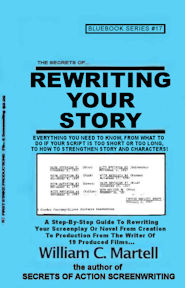
REWRITES Blue Book!
Rewriting In Waves?
When You Finish Your Screenplay Or Novel...
The Rewrites Begin!
The end is just the beginning! You’ve finished your story, but now the rewriting begins! This 405 page book shows you how to rewrite your screenplay or novel to perfection. Everything from Character Consistency to Shoeboxing to How To Give And Receive Notes to 15 Solutions If Your Script’s Too Long! and 15 Solutions If Your Script’s Too Short! to Finding The Cause Of A Story Problem to Good Notes Vs. Bad Notes to Finding Beta Readers to Avoiding Predictability to Learning To Be Objective About Your Work to Script Killer Notes and Notes From Idiots to Production Rewrites and What The Page Colors Mean? and a Complete Rewrite Checklist! The complete book on Rewriting Your Story!
Only $4.99
NEW ISH!
All About Endings!
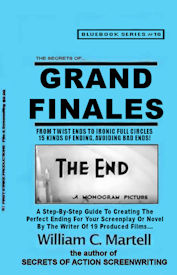
GRAND FINALES Blue Book!
The Perfect Ending For Your Story!
The First Ten Pages Of Your Screenplay Are Critical,
But What About The Last 10 Pages?
Creating the perfect ending to your story! This 100,000 word book shows you how to end your story with a bang, rather than a whimper. Everything from Resolution Order to Act Three Tools to Happy or Sad Endings? to How The Beginning Of Your Story Has Clues To The Ending (in case you were having trouble figuring out how the story should end) to Falling Action to How To Avoid Bad Endings to Writing The Perfect Twist Ending to Setting Up Sequels & Series to Emotional Resolutions to How To Write Post Credit Sequences to Avoiding Deus Ex Machinas, to 20 Different Types Of Ends (and how to write them) and much more! Everything about endings for your screenplay or novel!
Only: $4.99
NO KINDLE REQUIRED! Get the *free* app (any device, except your Mr. Coffee) on the order page on Amazon!
SHRINKING IT DOWN
All About LOGLINES, TREATMENTS, and PITCHING!

LOGLINES, TREATMENTS, and PITCHING! Blue Book!
Distilling Your Screenplay!
Loglines, Treatments, Pitching, Look Books, Pitch Decks, One Pagers, Rip-O-Matics?
You have written a brilliant 110 page screenplay, but how do you get anyone to read it? You need to distill it down into some form of verbal moonshine or story rocket fuel that will ignite that bored development executive or manager or agent and get them to request your screenplay. But how do you shrink those 110 pages into a 25 word logline or a 2 minute elevator pitch or a one page synopsis or a short paragraph? This 100,000 word book shows you how! Everything you need to know! From common logline mistakes (and how to solve them) to how your pitch can reveal story problems to the 4 types of pitches!
272 Pages - ONLY $4.99!
NEW in 2020!
Making Your Own Movie?
WRITE IT: FILM IT BOOK!

Making Your Own Movie?
Writing An Indie Film?
Writing A Low Budget Genre Script To Sell?
Writing A Made For TV Holiday Movie?
You will be writing for BUDGET. On a standard spec screenplay, you don’t have to think about budget, but these types of screenplays writing with budget in mind is critical!
If you are making your own movie, budget, is even more important - and you need to think about budget *before* you write your screenplay... or you will end up with a script that you can’t afford to make (or is a struggle to make). Everyone is making their own films these days, and even if you have done it before there are lots of great techniques in this book to get more money on screen - for less money! You can make a film that looks like it cost millions for pocket change.
344 Pages - ONLY: $7.99!
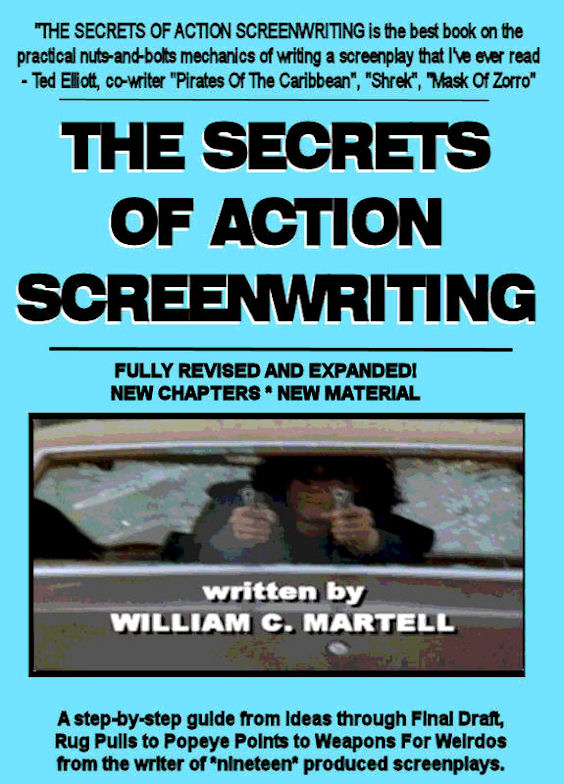
THE BOOK THAT STARTED IT ALL!
*** THE SECRETS OF ACTION SCREENWRITING *** - For Kindle!
*** THE SECRETS OF ACTION SCREENWRITING *** - For Nook!
Why pay $510 for a used version of the 240 page 2000 version that used to retail for $21.95? (check it out!) when
you can get the NEW EXPANDED VERSION - over 500 pages - for just $9.99? New chapters, New examples, New techniques!
"SECRETS OF ACTION SCREENWRITING is the
best book on the practical nuts-and-bolts mechanics of writing a screenplay I've ever read."
- Ted Elliott, co-writer of MASK OF ZORRO, SHREK, PIRATES OF THE CARIBBEAN and the sequels (with Terry Rossio). (ie; 4 of the top 20 Box Office Hits Of ALL TIME.)
Only $9.99 - and no postage!
BRAND NEW!
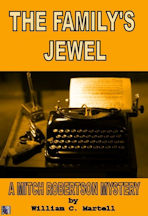
***
MITCH ROBERTSON #2: THE FAMILY'S JEWEL *** - For Kindle!
"The Presidential Suite of the Hollywood Hoover Hotel looked like a bloody battlefield: bodies everywhere, furniture broken, red liquid dripping from the walls, dead soldiers littering the elegant Berber rug as clouds of smoke overhead bounced between two air conditioning vents.
Mitch Robertson stepped over the body of an ex-child star turned sex tape star turned pop star and entered the room, spotted a gun on the floor and picked it up... careful not to spill his coffee with three pumps of mocha syrup from Penny’s Coffee Shop. That coffee was gold, the only thing keeping him going in this dazed state of wakefulness. The gun felt light. Holding it, he saw the silhouette of an 80s action star sitting sideways on a tipped over chair. Motionless. Was he dead? Mitch was still hung over from the Awards Party the night before, and wondered whether this was all some sort of crazy nightmare that he would wake up from... but when he tripped over the brown legs of a bottomless Superhero, flaccid junk encased in a condom but still wearing his mask, and hit the edge of the sofa, gun skittering and coffee spilling, he realized that it was all very real. What the hell had happened here?"
Short Novel. Only 99 cents! - and no postage!
Tips FAQ

My New Script Secrets Newsletter!

THE BLUE BOOKS!
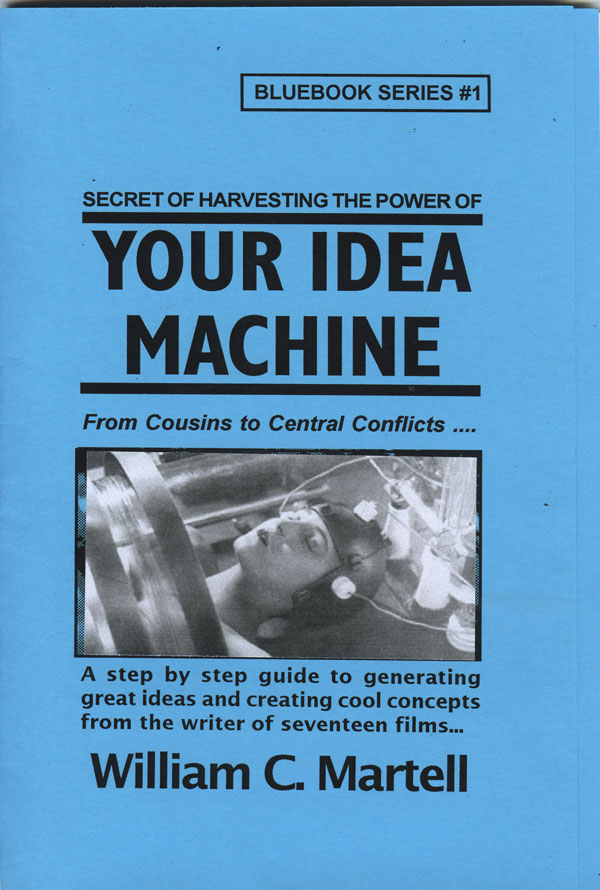
FIND A GREAT IDEA!
*** YOUR IDEA MACHINE *** - For Kindle!
****
Expanded version with more ways to find great ideas! Your screenplay is going to begin with an idea. There are good ideas and bad ideas and commercial ideas and personal ideas. But where do you find ideas in the first place? This handbook explores different methods for finding or generating ideas, and combining those ideas into concepts that sell. The Idea Bank, Fifteen Places To Find Ideas, Good Ideas And Bad Ideas, Ideas From Locations And Elements, Keeping Track Of Your Ideas, Idea Theft - What Can You Do? Weird Ways To Connect Ideas, Combing Ideas To Create Concepts, High Concepts - What Are They? Creating The Killer Concept, Substitution - Lion Tamers & Hitmen, Creating Blockbuster Concepts, Magnification And The Matrix, Conflict Within Concept, Concepts With Visual Conflict, Avoiding Episodic Concepts, much more! Print version is 48 pages, Kindle version is over 175 pages!
Only $4.99 - and no postage!
FIGURE OUT YOUR STORY!
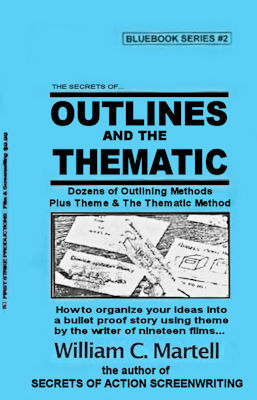
OUTLINES & THE THEMATIC Blue Book.
ARE YOUR SCENES IN THE RIGHT ORDER?
AND ARE THEY THE RIGHT SCENES?
Your story is like a road trip... but where are you going? What's the best route to get there? What are the best sights to see along the way? Just as you plan a vacation instead of just jump in the car and start driving, it's a good idea to plan your story. An artist does sketches before breaking out the oils, so why shouldn't a writer do the same? This Blue Book looks at various outlining methods used by professional screenwriters like Wesley Strick, Paul Schrader, John August, and others... as well as a guest chapter on novel outlines. Plus a whole section on the Thematic Method of generating scenes and characters and other elements that will be part of your outline. The three stages of writing are: Pre-writing, Writing, and Rewriting... this book looks at that first stage and how to use it to improve your screenplays and novels.
Only $4.99 - and no postage!
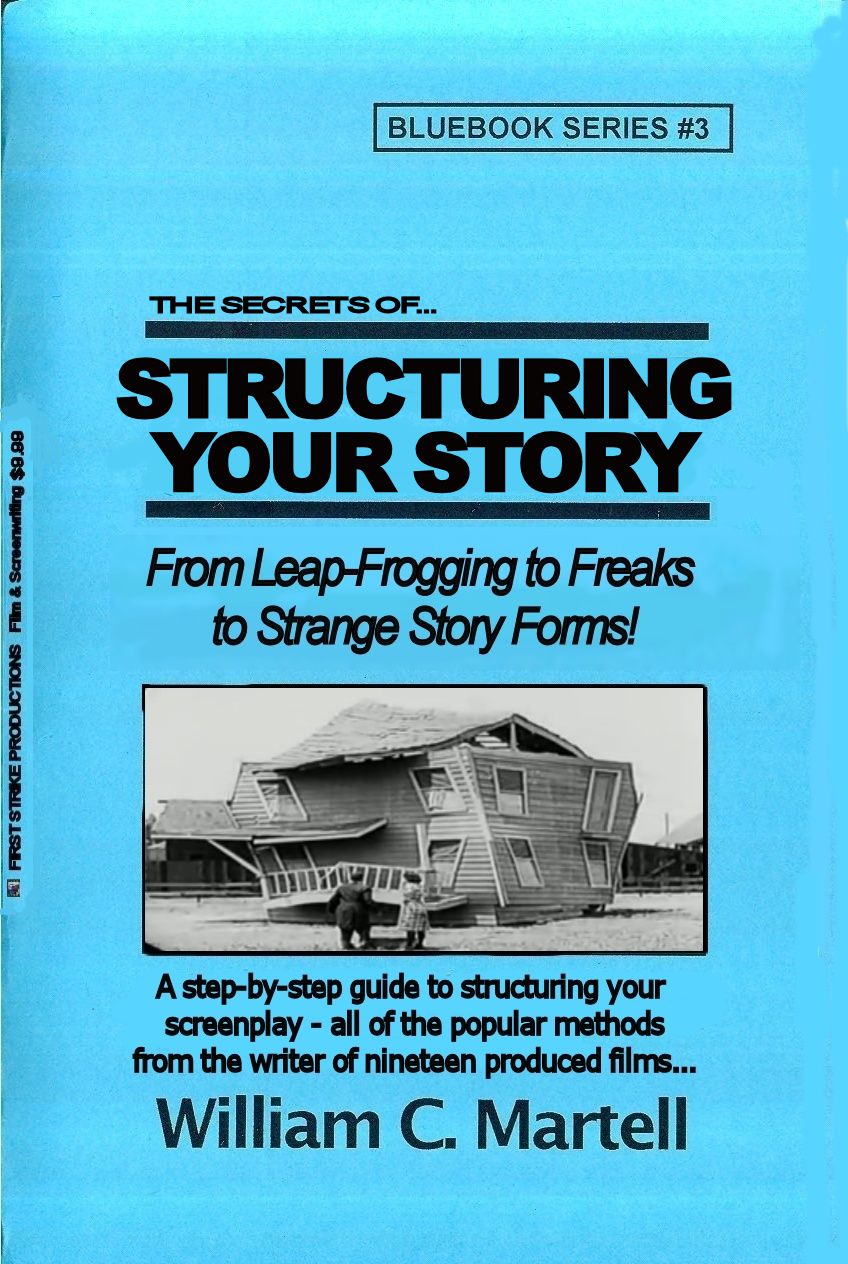
GOT STRUCTURE?!
*** STRUCTURING YOUR STORY *** - For Kindle!
William Goldman says the most important single element of any screenplay is structure. It’s the skeleton under the flesh and blood of your story. Without it, you have a spineless, formless, mess... a slug! How do you make sure your structure is strong enough to support your story? How do you prevent your story from becoming a slug? This Blue Book explores different types of popular structures from the basic three act structure to more obscure methods like leap-frogging. We also look at structure as a verb as well as a noun, and techniques for structuring your story for maximum emotional impact. Most of the other books just look at *structure* and ignore the art of *structuring* your story. Techniques to make your story a page turner... instead of a slug!
Only $4.99 - and no postage!

STORY: WELL TOLD!
*** STORY: WELL TOLD *** - For Kindle!
This book takes you step-by-step through the construction of a story... and how to tell a story well, why Story always starts with character... but ISN'T character, Breaking Your Story, Irony, Planting Information, Evolving Story, Leaving No Dramatic Stone Unturned, The Three Greek Unities, The Importance Of Stakes, The Thematic Method, and how to create personal stories with blockbuster potential. Ready to tell a story?
Print version was 48 pages, Kindle version is over 85,000 words - 251 pages!
Only $4.99 - and no postage!

START STRONG!
*** HOOK 'EM IN TEN *** - For Kindle!
Your story doesn't get a second chance to make a great first impression, and this book shows you a
bunch of techniques on how to do that. From the 12 Basic Ways To Begin Your Story, to the 3 Stars Of
Your First Scene (at least one must be present) to World Building, Title Crawls, Backstory, Starting
Late, Teasers and Pre Title Sequences, Establishing Theme & Motifs (using GODFATHER PART 2), Five Critical
Elements, Setting Up The Rest Of The Story (with GODFATHER), and much more! With hundreds of examples
ranging from Oscar winners to classic films like CASABLANCA to some of my produced films (because
I know exactly why I wrote the scripts that way). Biggest Blue Book yet!
Print version was 48 pages, Kindle version is over 100,000 words - 312 pages!
Only $4.99 - and no postage!
NO KINDLE REQUIRED! Get the *free* app (any device, except your Mr. Coffee) on the order page on Amazon!
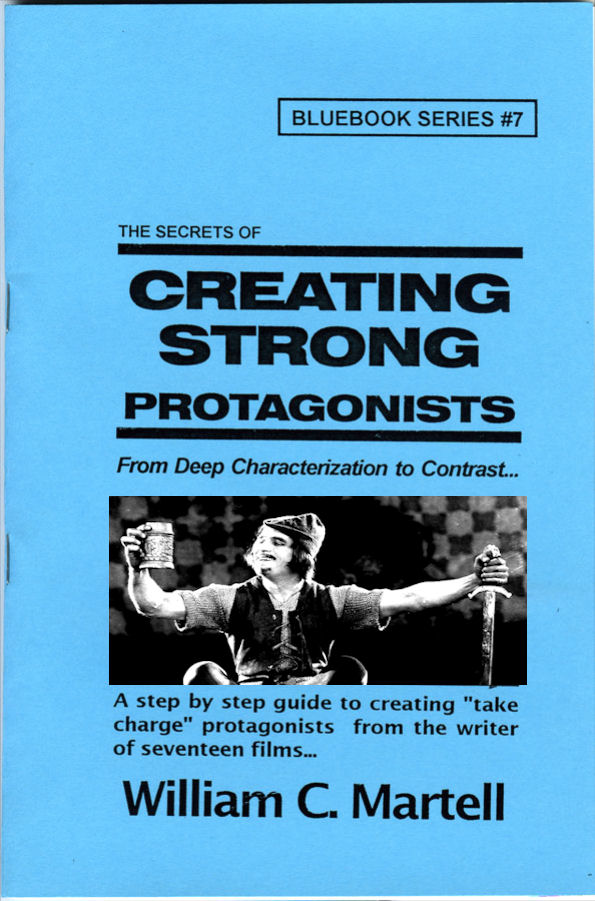
MOVIES ARE CHARACTERS!
*** CREATING STRONG PROTAGONISTS *** - For Kindle!
*** CREATING STRONG PROTAGONISTS *** - For Nook!
Expanded version with more ways to create interesting protagonists! A step-by-step guide to creating "take charge" protagonists. Screenplays are about characters in conflict... characters in emotional turmoil... Strong three dimensional protagonists who can find solutions to their problems in 110 pages. But how do you create characters like this? How do you turn words into flesh and blood? Character issues, Knowing Who Is The Boss, Tapping into YOUR fears, The Naked Character, Pulp Friction, Man With A Plan, Character Arcs, Avoiding Cliche People, Deep Characterization, Problem Protagonists, 12 Ways To Create Likable Protagonists (even if they are criminals), Active vs. Reactive, The Third Dimension In Character, Relationships, Ensemble Scripts, and much, much more. Print version is 48 pages, Kindle version is once again around 205 pages!
ONLY $4.99 - and no postage!
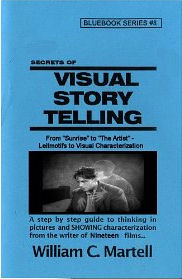
I WRITE PICTURES!
*** VISUAL STORYTELLING *** - For Kindle! (exclusive)
Show Don't Tell - but *how* do you do that? Here are techniques to tell stories visually! Using Oscar Winning Films and Oscar Nominated Films as our primary examples: from the first Best Picture Winner "Sunrise" (1927) to the Oscar Nominated "The Artist" (which takes place in 1927) with stops along the way Pixar's "Up" and Best Original Screenplay Winner "Breaking Away" (a small indie style drama - told visually) as well as "Witness" and other Oscar Winners as examples... plus RISE OF THE PLANET OF THE APES. Print version is 48 pages, Kindle version is over 200 pages!
ONLY $4.99 - and no postage!
DESCRIPTION & VOICE Blue Book!
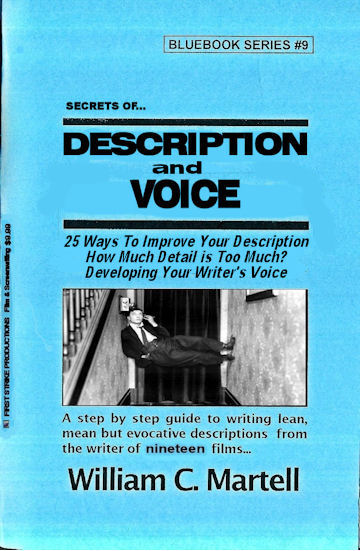
DESCRIPTION & VOICE Blue Book.
IS HALF OF YOUR STORY IN TROUBLE?
Most screenplays are about a 50/50 split between dialogue and description - which means your description is just as important as your dialogue. It just gets less press because the audience never sees it, the same reason why screenwriters get less press than movie stars. But your story will never get to the audience until readers and development executives read your script... so it is a very important factor. Until the movie is made the screenplay is the movie and must be just as exciting as the movie. So how do you make your screenplay exciting to read? Description is important in a novel as well, and the “audience” does read it... how do we write riveting description?
Only $4.99 and no postage!

PRO DIALOGUE TECHNIQUES!
*** DIALOGUE SECRETS *** - For Kindle!
***
Expanded version with more ways to create interesting dialogue! How to remove bad dialogue (and what *is* bad dialogue), First Hand Dialogue, Awful Exposition, Realism, 50 Professional Dialogue Techniques you can use *today*, Subtext, Subtitles, Humor, Sizzling Banter, *Anti-Dialogue*, Speeches, and more. Tools you can use to make your dialogue sizzle! Special sections that use dialogue examples from movies as diverse as "Bringing Up Baby", "Psycho", "Double Indemnity", "Notorious", the Oscar nominated "You Can Count On Me", "His Girl Friday", and many more! Print version is 48 pages, Kindle version is over 175 pages!
Only $4.99 - and no postage!

WHAT IS A SCENE?
*** SCENE SECRETS *** - For Kindle!
***
What is a scene and how many you will need? The difference between scenes and sluglines. Put your scenes on trial for their lives! Using "Jaws" we'll look at beats within a scene. Scene DNA. Creating set pieces and high concept scenes. A famous director talks about creating memorable scenes. 12 ways to create new scenes. Creating unexpected scenes. Use dramatic tension to supercharge your scenes. Plants and payoffs in scenes. Plus transitions and buttons and the all important "flow"... and more! Over 65,000 words! Print version was 48 pages, Kindle version is around 210 pages!
Only $4.99 - and no postage!
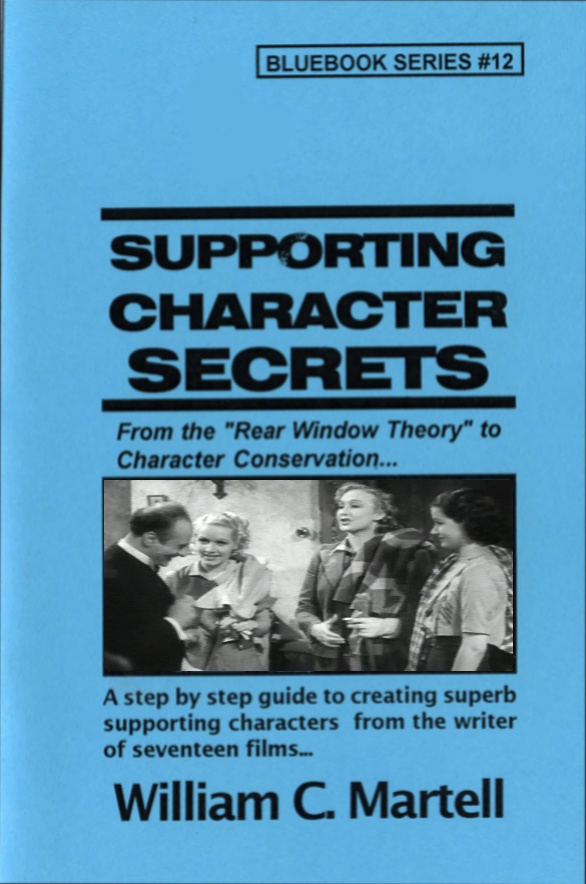
SUBPLOTS?
*** SUPPORTING CHARACTER SECRETS *** - For Kindle! (Exclusive)
Expanded version with more techniques to flesh out your Supporting Characters and make them individuals. Using the hit movie BRIDESMAIDS as well as other comedies like THE HANGOVER and TED and HIGH FIDELITY and
40 YEAR OLD VIRGIN and many other examples we look at ways to make your Supporting Characters come alive on the page.
Print version was 48 pages, Kindle version is around 170 pages!
ONLY $4.99 - and no postage!
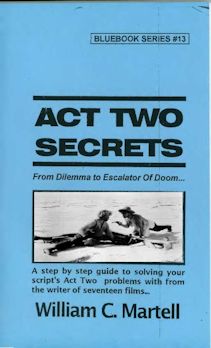
ACT TWO SOLUTIONS!
*** ACT TWO SECRETS *** - For Kindle!
Expanded version with more techniques to help you through the desert of Act Two! Subjects Include: What Is Act Two? Inside Moves, The 2 Ps: Purpose & Pacing, The 4Ds: Dilemma, Denial, Drama and Decision, Momentum, the Two Act Twos, Subplot Prisms, Deadlines, Drive, Levels Of Conflict, Escalation, When Act Two Begins and When Act Two Ends, Scene Order, Bite Sized Pieces, Common Act Two Issues, Plot Devices For Act Two, and dozens of others. Over 67,000 words (that’s well over 200 pages) of tools and techniques to get you through the desert of Act Two alive!
Print version was 48 pages, Kindle version is well over 200 pages!
ONLY $4.99 - and no postage!
READY TO BREAK IN?
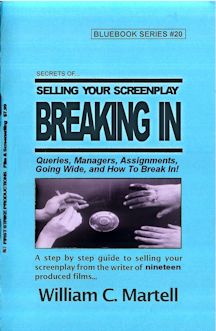
THE BUISINESS SIDE
*** BREAKING IN BLUE BOOK *** - For Kindle!
Should really be called the BUSINESS BLUE BOOK because it covers almost everything you will need to
know for your screenwriting career: from thinking like a producer and learning to speak their language,
to query letters and finding a manager or agent, to making connections (at home and in Hollywood) and
networking, to the different kinds of meetings you are will have at Studios, to the difference between
a producer and a studio, to landing an assignment at that meeting and what is required of you when you
are working under contract, to contracts and options and lawyers and... when to run from a deal!
Information you can use *now* to move your career forward! It's all here in the Biggest Blue Book yet!
Print version was 48 pages, Kindle version is over 400 pages!
$4.99 - and no postage!

STORY IN ACTION SERIES!

THE MISSION IMPOSSIBLE MOVIES
NEW: Updates On Films 7 & 8 Casting!
All Six Movies analyzed! All of the mission tapes, all of the “that’s impossible!” set pieces and stunts, the cons and capers - and how these scenes work, the twists and double crosses, the tension and suspense (and how to generate it), the concept of each film as a stand alone with a different director calling the shots (broken in the sixth film), the gadgets, the masks, the stories, the co-stars and team members (one team member has been in every film), the stunts Tom Cruise actually did (and the ones he didn’t), and so much more! Over 120,000 words of fun info!
THE MISSION IMPOSSIBLE MOVIES - 347 Pages - Only $3.99 !

BRAND NEW!
*** THE BOURNE MOVIES
NEW: Updates on TREADSTONE TV show!
All five "Bourne" movies (including "Legacy" and it's potential sequels) - what are the techniques used to keep the characters and scenes exciting and involving? Reinventing the thriller genre...
or following the "formula"? Five films - each with an interesting experiment! A detailed analysis of each
of the films, the way these thrillers work... as well as a complete list of box office and critical
statistics for each film. This book is great for writers, directors, and just fans of the series.
Only $3.99 - and no postage!
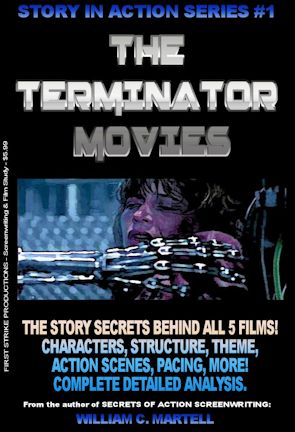
Over 240 pages!
*** THE TERMINATOR MOVIES *** - For Kindle!
He's back! The release of "Terminator: Dark Fate" is set to begin a new trilogy in
the Terminator story... 35 years after the first film was released. What draws us to these films about
a cybernetic organism from the future sent back in time? Why is there a new proposed trilogy every few
years? This book looks at all five Terminator movies from a story standpoint - what makes them work
(or not)? What are the techniques used to keep the characters and scenes exciting and involving? How
about those secret story details you may not have noticed? Containing a detailed analysis of each of
the five films so far, this book delves into the way these stories work... as well as a complete list of
box office and critical statistics for each film. This book is great for writers, directors, and just
fans of the series.
ONLY $3.99 - and no postage!
HITCHCOCK FOR WRITERS!
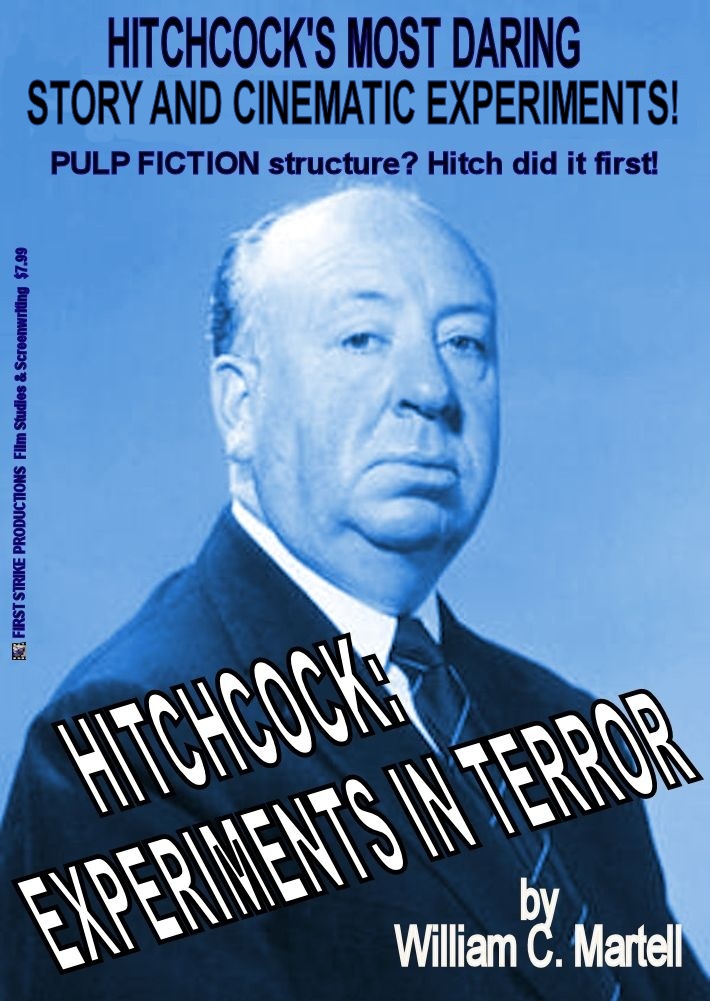
Strange Structures!
*** HITCHCOCK: EXPERIMENTS IN TERROR! *** - For Kindle!
***
Contained Thrillers like "Buried"? Serial Protagonists like "Place Beyond The Pines"? Multiple Connecting Stories like "Pulp Fiction"? Same Story Multiple Times like "Run, Lola, Run"?
HITCHCOCK DID IT FIRST!
This book focuses on 18 of Hitchcock's 52 films with wild cinema and story experiments which paved the way for modern films. Almost one hundred different experiments that you may think are recent cinema or story inventions... but some date back to Hitchcock's *silent* films! We'll examine these experiments and how they work. Great for film makers, screenwriters, film fans, producers and directors.
Only $5.99 - and no postage!
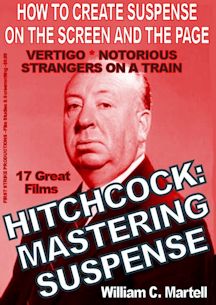
LEARN SUSPENSE FROM THE MASTER!
*** HITCHCOCK: MASTERING SUSPENSE *** - For Kindle!
Alfred Hitchcock, who directed 52 movies, was known as the *Master Of Suspense*; but what exactly is suspense and how can *we* master it? How does suspense work? How can *we* create “Hitchcockian” suspense scenes in our screenplays, novels, stories and films?
This book uses seventeen of Hitchcock’s films to show the difference between suspense and surprise, how to use “focus objects” to create suspense, the 20 iconic suspense scenes and situations, how plot twists work, using secrets for suspense, how to use Dread (the cousin of suspense) in horror stories, and dozens of other amazing storytelling lessons. From classics like “Strangers On A Train” and “The Birds” and “Vertigo” and “To Catch A Thief” to older films from the British period like “The 39 Steps” and “The Man Who Knew Too Much” to his hits from the silent era like “The Lodger” (about Jack The Ripper), we’ll look at all of the techniques to create suspense!
Only $5.99
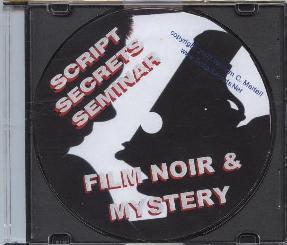
AUDIO CLASS!
NOIR & MYSTERY80 minute MP3 packed with information on writing Film Noir and Mystery scripts. Using examples from CHINATOWN to OUT OF THE PAST to DOUBLE INDEMNITY you'll learn how to create stories in this dark, twisted genre. How to plant clues, red herrings, suspects, victims, spider women, fallen heroes, the funhouse mirror world of noir supporting characters... and the origins of Film Noir in literature Noir dialogue and how noir endings are different than any other genre. All of the critical elements necessary to write in this critically popular genre.
The Noir & Mystery Class is only $15 (plus $5 S&H). First 20 on Limited Black Disk!
PAMDEMIC SALE! $5 OFF!
IDEAS AND CREATIVITY - 80 minute MP3 packed with information. Tools to find ideas that are both personal *and* commercial. Hollywood wants scripts with High Concept stories... but not stupid scripts. Developing *intelligent* high concept ideas. How to turn your personal story into a blockbuster - or find your personal story in a high concept idea. Brainstorming and being creative. Ideas and Creativity is $10.00 (plus $5 S&H)
WRITING INDIES - Writing an Indie film? This class covers everything you need to know - from Central Locations to Confined Cameos. Using examples from SWINGERS, THE COOLER, STATION AGENT and others, this 80 minute MP3 is packed with information. How Indoe films challenge the audience (while mainstream films reassure the audience). Structures, using BOYS DON'T CRY, RUN LOLA RUN, HILARY & JACKIE, and others as example. Writing for a budget, writing for non-actors, getting the most production value out of your budget. Writing Indies is $10.00 (plus $5 S&H)
WRITING HORROR - The essentials of a horror screenplay - what do ROSEMARY'S BABY, NIGHT OF THE LIVING DEAD, THE EXORCIST, BRIDE OF FRANKENSTEIN, THE OTHERS and OPEN WATER have in common? This class will tell you! All of the critical elements necessary to write a script that scares the pants off the audience. Writing Horror is $10.00 (plus $5 S&H).
Click here for more information on CLASS MP3s!

Use your creative energy to focus on the content; let Final Draft take care of the style. Final Draft is the number-one selling application specifically designed for writing movie scripts, television episodics and stage plays. Its ease-of-use and time-saving features have attracted writers for almost two decades positioning Final Draft as the Professional Screenwriters Choice. Final Draft power users include Academy, Emmy and BAFTA award winning writers like Oliver Stone, Tom Hanks, Alan Ball, J.J. Abrams, James Cameron and more.
* * * Buy It!
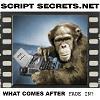
|

